Opinion Evolution in Divided Community
Abstract
:1. Introduction
2. Models and Methods
2.1. Modelling Framework
- A binary opinion model with a single trait.
- q-voter model with conformity and anti-conformity as the general modeling framework.
- Double clique topology as the underlying social network.
- Conformity between agents within a clique and anti-conformity in the interactions between the cliques.
- Pick a target agent at random.
- Choose randomly q neighbors of the target (possibility of repetition).
- If all the q neighbors are in the same state, the target changes its state accordingly.
- Otherwise, the target changes its state with probability .
2.2. Independence of Agents
2.3. Quenched and Annealed Disorder Models
2.4. Updating Rules of the Models
- Pick a target agent at random (uniformly from nodes).
- Draw a random number form a uniform distribution, .
- If (i.e., with probability h), the agent is independent:
- (a)
- Change its state with probability . To this end, draw a random number f from a uniform distribution, :
- if , change the state of the target, i.e., ,
- otherwise, do nothing.
- (b)
- Go to step 1.
- If (i.e., with probability ), the agent is subject to social influence:
- (a)
- Randomly choose a group of q distinct neighbors of the target node:
- Quenched model
- simply look at the actual neighbors of the target (sampling with replacement).
- Annealed model
- first decide to which clique every member of the influence group will belong (with probability to the target’s clique, with p to the other one), then randomly choose the member from the appropriate clique.
- (b)
- Convert the states of the group members to signals. Assume that the signals of the neighbors from target’s clique are equal to their states. Invert the states when from the other clique.
- (c)
- Calculate the total signal of the influence group by summing up the individual signals of its members.
- (d)
- If the total signal is equal to (i.e., all group members emit the same signal), the target changes its opinion accordingly (see Figure 2). Otherwise, nothing happens.
- Go to step 1.
2.5. Quantities of Interest
2.6. Transition Probabilities and Dynamical System
- a target from clique A is chosen (probability ),
- the target is in state (probability ),
- it flips due to independence (probability ) or follows an influence group emitting signal .
- A target from clique A is chosen (probability ).
- The target is in state (probability ).
- It flips due to independence (probability ) or follows an influence group emitting signal .
3. Results
3.1. Direction Fields and Stationary Points
3.2. Time Evolution of the System
3.3. Impact of Independence on the System
4. Discussion
Author Contributions
Funding
Institutional Review Board Statement
Informed Consent Statement
Data Availability Statement
Conflicts of Interest
References
- DiMaggio, P.; Evans, J.; Bryson, B. Have American’s Social Attitudes Become More Polarized? Am. J. Sociol. 1996, 102, 690–755. [Google Scholar] [CrossRef]
- Mäs, M.; Flache, A. Differentiation without Distancing. Explaining Bi-Polarization of Opinions without Negative Influence. PLoS ONE 2013, 8, e74516. [Google Scholar] [CrossRef] [PubMed] [Green Version]
- Isenberg, D.J. Group polarization: A critical review and meta-analysis. J. Personal. Soc. Psychol. 1986, 50, 1141–1151. [Google Scholar] [CrossRef]
- Sunstein, C.R. The Law of Group Polarization. J. Political Philos. 2002, 10, 175–195. [Google Scholar] [CrossRef]
- Bail, C.A.; Argyle, L.P.; Brown, T.W.; Bumpus, J.P.; Chen, H.; Hunzaker, M.B.F.; Lee, J.; Mann, M.; Merhout, F.; Volfovsky, A. Exposure to opposing views on social media can increase political polarization. Proc. Natl. Acad. Sci. USA 2018, 115, 9216–9221. [Google Scholar] [CrossRef] [PubMed] [Green Version]
- The Global Risk Report 2017; World Economic Forum: Geneva, Switzerland, 2017.
- Mouw, T.; Sobel, M. Culture Wars and Opinion Polarization: The Case of Abortion. Am. J. Sociol. 2001, 106, 913–943. [Google Scholar] [CrossRef] [Green Version]
- McCright, A.M.; Dunlap, R.E. The politization of climate change and polarization in the American public’s views of global warming. Sociol. Q. 2011, 52, 2001–2010. [Google Scholar] [CrossRef]
- Gruzd, A.; Roy, J. Investigating Political Polarization on Twitter: A Canadian Perspective. Policy Internet 2014, 6, 28–45. [Google Scholar] [CrossRef]
- Adamic, L.A.; Glance, N. The political blogosphere and the 2004 US election: Divided they blog. In Proceedings of the 3rd International Workshop on Link Discovery (LinkKDD ’05), Chicago, IL, USA, 21–25 August 2005; pp. 36–43. [Google Scholar]
- Maoz, Z. Network Polarization, Network Interdependence, and International Conflict. J. Peace Res. 2006, 43, 1816–2002. [Google Scholar] [CrossRef]
- Waugh, A.; Pei, L.; Fowler, J.H.; Mucha, P.J.; Porter, M.A. Party Polarization in Congress: A Network Science Approach. arXiv 2011, arXiv:0907.3509. [Google Scholar]
- Pariser, E. The Filter Bubble. What the Internet Is Hiding from You? Penguin Press: New York, NY, USA, 2011. [Google Scholar]
- Axelrod, R. The Dissemination of Culture. A Model with Local Convergence and Global Polarization. J. Confl. Resolut. 1997, 41, 203–226. [Google Scholar] [CrossRef] [Green Version]
- McPherson, M.; Smith-Lovin, L.; Cook, J.M. Birds of a Feather: Homophily in Social Networks. Annu. Rev. Sociol. 2001, 27, 415–444. [Google Scholar] [CrossRef] [Green Version]
- Hengselmann, R.; Krause, U. Opinion dynamics and bounded confidence: Models, analysis and simulation. J. Artif. Soc. Soc. Simul. 2002, 5, 1–33. [Google Scholar]
- Deffuant, G.; Neau, D.; Amblard, F.; Weisbuch, G. Mixing beliefs among interacting agents. Adv. Complex Syst. 2000, 03, 87–98. [Google Scholar] [CrossRef]
- Macy, M.W.; Kitts, J.; Flache, A.; Benard, S. Polarization and Dynamic Networks. A Hopfield Model of Emergent Structure. In Dynamic Social Network Modeling and Analysis: Workshop Summary and Papers; Breiger, R., Carley, K., Pattison, P., Eds.; The National Academies Press: Washington, DC, USA, 2003; pp. 162–173. [Google Scholar]
- Salzarulo, L. A Continuous Opinion Dynamics Model Based on the Principle of Meta-Contrast. J. Artif. Soc. Soc. Simul. 2006, 9, 13. [Google Scholar]
- Traag, V.A.; Dooren, P.V.; Leenheer, P.D. Dynamical Models Explaining Social Balance and Evolution of Cooperation. PLoS ONE 2013, 8, e60063. [Google Scholar] [CrossRef] [PubMed]
- Siedlecki, P.; Szwabiński, J.; Weron, T. The interplay between conformity and anticonformity and its polarizing effect on society. J. Artif. Soc. Soc. Simul. 2016, 19, 9. [Google Scholar] [CrossRef] [Green Version]
- Krueger, T.; Szwabiński, J.; Weron, T. Conformity, anticonformity and polarization of opinions: Insights from a mathematical model of opinion dynamics. Entropy 2017, 19, 371. [Google Scholar] [CrossRef]
- Lambiotte, R.; Ausloos, M.; Hołyst, J.A. Majority model on a network with communities. Phys. Rev. E 2007, 75, 030101. [Google Scholar] [CrossRef] [Green Version]
- Suchecki, K.; Hołyst, J.A. Bistable-monostable transition in the Ising model on two connected complex networks. Phys. Rev. E 2009, 80, 031110. [Google Scholar] [CrossRef] [Green Version]
- Martins, A.C.R. Continuous Opinions and Discrete Actions in Opinion Dynamics Problems. Int. J. Mod. Phys. C 2008, 19, 617–624. [Google Scholar] [CrossRef]
- Martins, A.C.R.; Galam, S. Building up of individual inflexibility in opinion dynamics. Phys. Rev. E 2013, 87, 042807. [Google Scholar] [CrossRef] [PubMed] [Green Version]
- Banisch, S.; Olbrich, E. Opinion polarization by learning from social feedback. J. Math. Sociol. 2019, 43, 76–103. [Google Scholar] [CrossRef]
- Nail, P.R. Toward an integration of some models and theories of social response. Psychol. Bull. 1986, 100, 190–206. [Google Scholar] [CrossRef]
- Nail, P.R.; MacDonald, G.; Levy, D.A. Proposal of a Four Dimensional Model of Social Response. Psychol. Bull. 2000, 126, 454–470. [Google Scholar] [CrossRef] [PubMed]
- Nyczka, P.; Sznajd-Weron, K. Anticonformity or Independence?—Insights from Statistical Physics. J. Stat. Phys. 2013, 151, 174–202. [Google Scholar] [CrossRef]
- Conover, M.; Ratkiewicz, J.; Francisco, M.; Gonçalves, B.; Flammini, A.; Menczer, F. Political Polarization on Twitter. In Proceedings of the Fifth International AAAI Conference on Weblogs and Social Media (ICWSM), Barcelona, Spain, 17–21 July 2011; pp. 89–96. [Google Scholar]
- Newman, M.E.J. Modularity and community structure in networks. Proc. Natl. Acad. Sci. USA 2006, 103, 8577–8582. [Google Scholar] [CrossRef] [Green Version]
- Zachary, W. An Information Flow Model for Conflict and Fission in Small Groups. J. Anthropol. Res. 1977, 33, 452–473. [Google Scholar] [CrossRef] [Green Version]
- Sood, V.; Antal, T.; Redner, S. Voter models on heterogeneous networks. Phys. Rev. E 2008, 77, 041121. [Google Scholar] [CrossRef] [Green Version]
- Watts, D.J.; Dodds, P.S. Influentials, Networks, and Public Opinion Formation. J. Consum. Res. 2007, 34, 441–458. [Google Scholar] [CrossRef]
- Guerra, P.H.C.; Meira, M., Jr.; Cardie, C.; Kleinberg, R. A Measure of Polarization on Social Media Networks Based on Community Boundaries. In Proceedings of the Seventh International AAAI Conference on Web and Social Media, Cambridge, MA, USA, 8–11 July 2013; pp. 215–224. [Google Scholar]
- Castellano, C.; Muñoz, M.A.; Pastor-Satorras, R. Nonlinear q-voter model. Phys. Rev. E 2009, 80, 041129. [Google Scholar] [CrossRef] [PubMed] [Green Version]
- Myers, D.G. Social Psychology, 11th ed.; Freeman Press: New York, NY, USA, 2013. [Google Scholar]
- Bond, R. Group Size and Conformity. Group Process. Intergroup Relat. 2005, 8, 331–354. [Google Scholar] [CrossRef]
- Asch, S.E. Opinions and Social Pressure. Sci. Am. 1955, 193, 31–35. [Google Scholar] [CrossRef]
- Nyczka, P.; Sznajd-Weron, K.; Cislo, J. Phase transitions in the q-voter model with two types of stochastic driving. Phys. Rev. E 2012, 86, 011105. [Google Scholar] [CrossRef] [PubMed] [Green Version]
- Nyczka, P.; Byrka, K.; Nail, P.R.; Sznajd-Weron, K. Conformity in numbers—Does criticality in social responses exist? PLoS ONE 2018, 13, 1–18. [Google Scholar] [CrossRef] [PubMed]
- Przybyła, P.; Sznajd-Weron, K.; Weron, R. Diffusion of innovation within an agent-based model: Spinsons, independence and advertising. Adv. Complex Syst. 2014, 17, 1450004. [Google Scholar] [CrossRef]
- Sznajd-Weron, K.; Szwabiński, J.; Weron, R. Is the Person-Situation Debate Important for Agent-Based Modeling and Vice-Versa? PLoS ONE 2014, 9, e112203. [Google Scholar] [CrossRef]
- Jędrzejewski, A.; Sznajd-Weron, K.; Szwabiński, J. Mapping the q-voter model: From a single chain to complex networks. Phys. A 2016, 446, 110–119. [Google Scholar] [CrossRef] [Green Version]
- Jędrzejewski, A.; Sznajd-Weron, K. Person-Situation Debate Revisited: Phase Transitions with Quenched and Annealed Disorders. Entropy 2017, 19, 415. [Google Scholar] [CrossRef] [Green Version]
- Jędrzejewski, A.; Marcjasz, G.; Nail, P.R.; Sznajd-Weron, K. Think then act or act then think? PLoS ONE 2018, 13, 1–19. [Google Scholar] [CrossRef]
- Jędrzejewski, A.; Sznajd-Weron, K. Impact of memory on opinion dynamics. Phys. A Stat. Mech. Its Appl. 2018, 505, 306–315. [Google Scholar] [CrossRef] [Green Version]
- Galam, S.; Moscovici, S. Towards a theory of collective phenomena: Consensus and attitude changes in groups. Eur. J. Soc. Psychol. 1991, 21, 49–74. [Google Scholar] [CrossRef]
- Galam, S. Rational group decision making: A random field Ising model at T = 0. Phys. A 1997, 238, 66–80. [Google Scholar] [CrossRef] [Green Version]
- Galam, S.; Jacobs, F. The role of inflexible minorities in the breaking of democratic opinion dynamics. Phys. A 2007, 381, 366–376. [Google Scholar] [CrossRef] [Green Version]
- Mobilia, M. Does a Single Zealot Affect an Infinite Group of Voters? Phys. Rev. Lett. 2003, 91, 028701. [Google Scholar] [CrossRef] [Green Version]
- Nail, P.R.; Domenico, S.I.; MacDonald, G. Proposal of a Double Diamond Model of Social Response. Rev. Gen. Psychol. 2013, 17, 1–19. [Google Scholar] [CrossRef]
- Galam, S. Contrarian deterministic effects on opinion dynamics: “The hung elections scenario”. Phys. A 2004, 333, 453–460. [Google Scholar] [CrossRef] [Green Version]
- Sznajd-Weron, K.; Tabiszewski, M.; Timpanaro, A. Phase transition in the Sznajd model with independence. Europhys. Lett. 2011, 96, 48002. [Google Scholar] [CrossRef] [Green Version]
- Liu, T.; Bundschuh, R. Quantification of the differences between quenched and annealed averaging for RNA secondary structures. Phys. Rev. E 2005, 72, 061905. [Google Scholar] [CrossRef] [Green Version]
- Strogatz, S.H. Nonlinear Dynamics and Chaos: With Applications to Physics, Biology, Chemistry, and Engineering; Addison-Wesley: Reading, MA, USA, 1994. [Google Scholar]
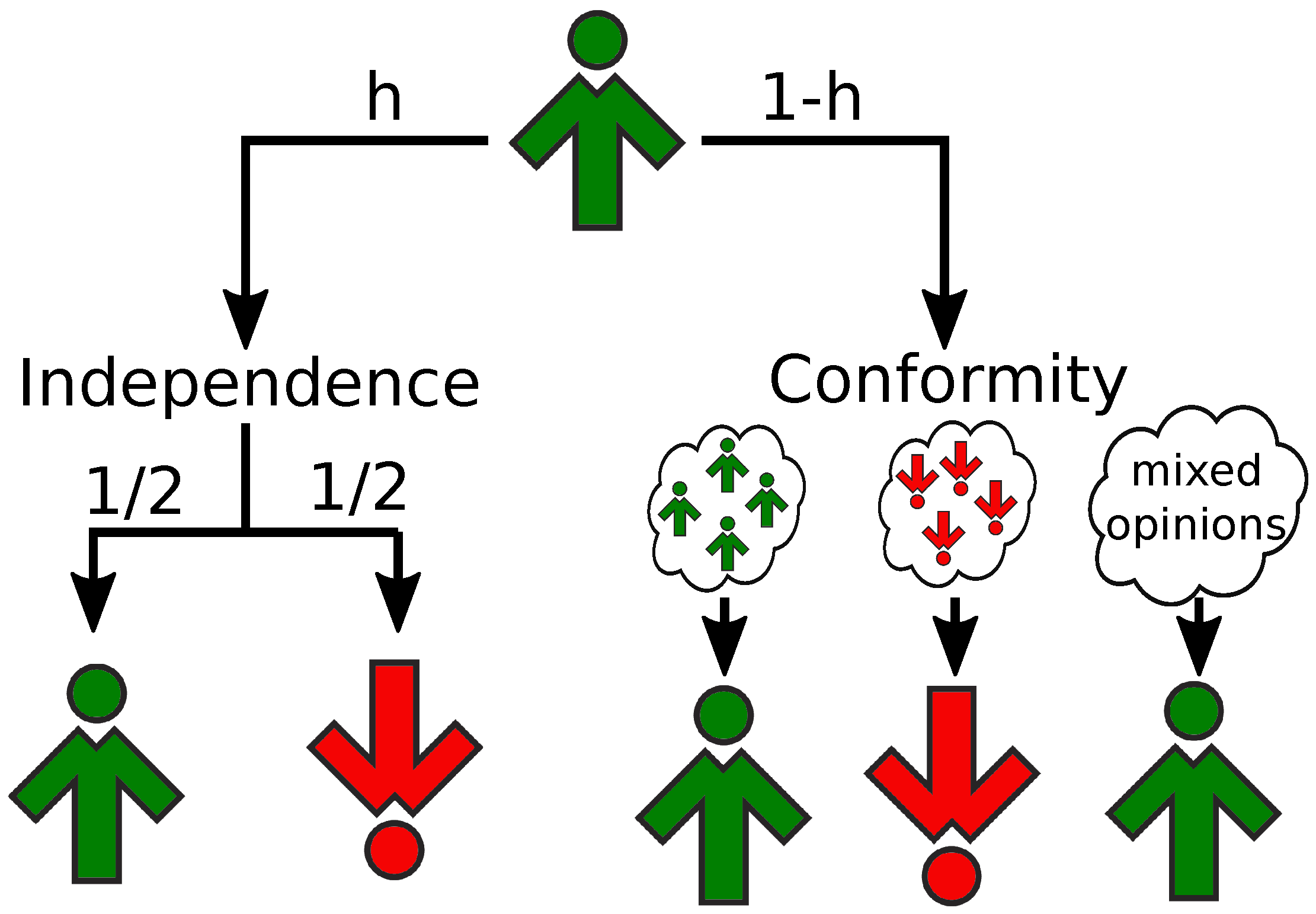
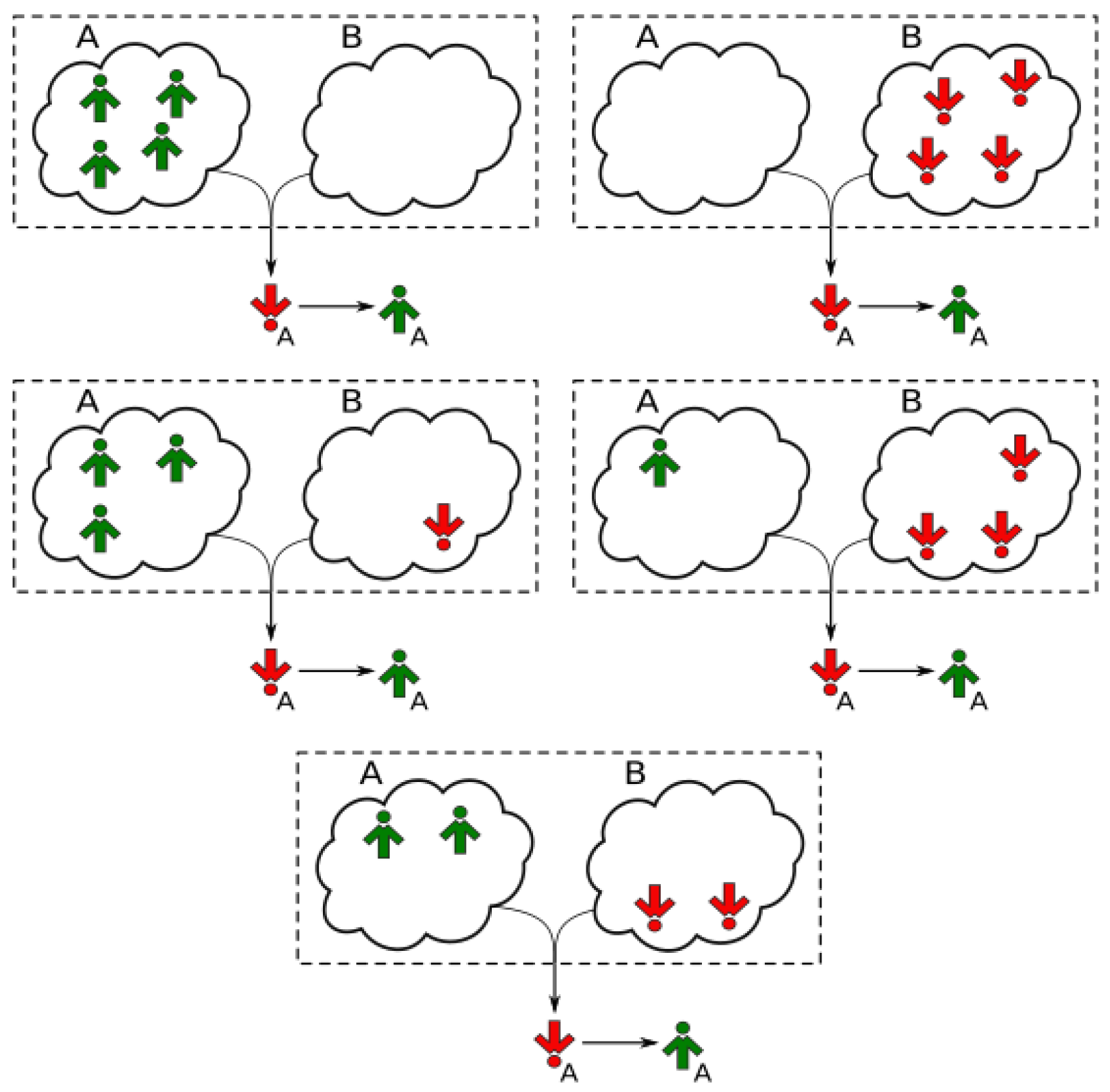
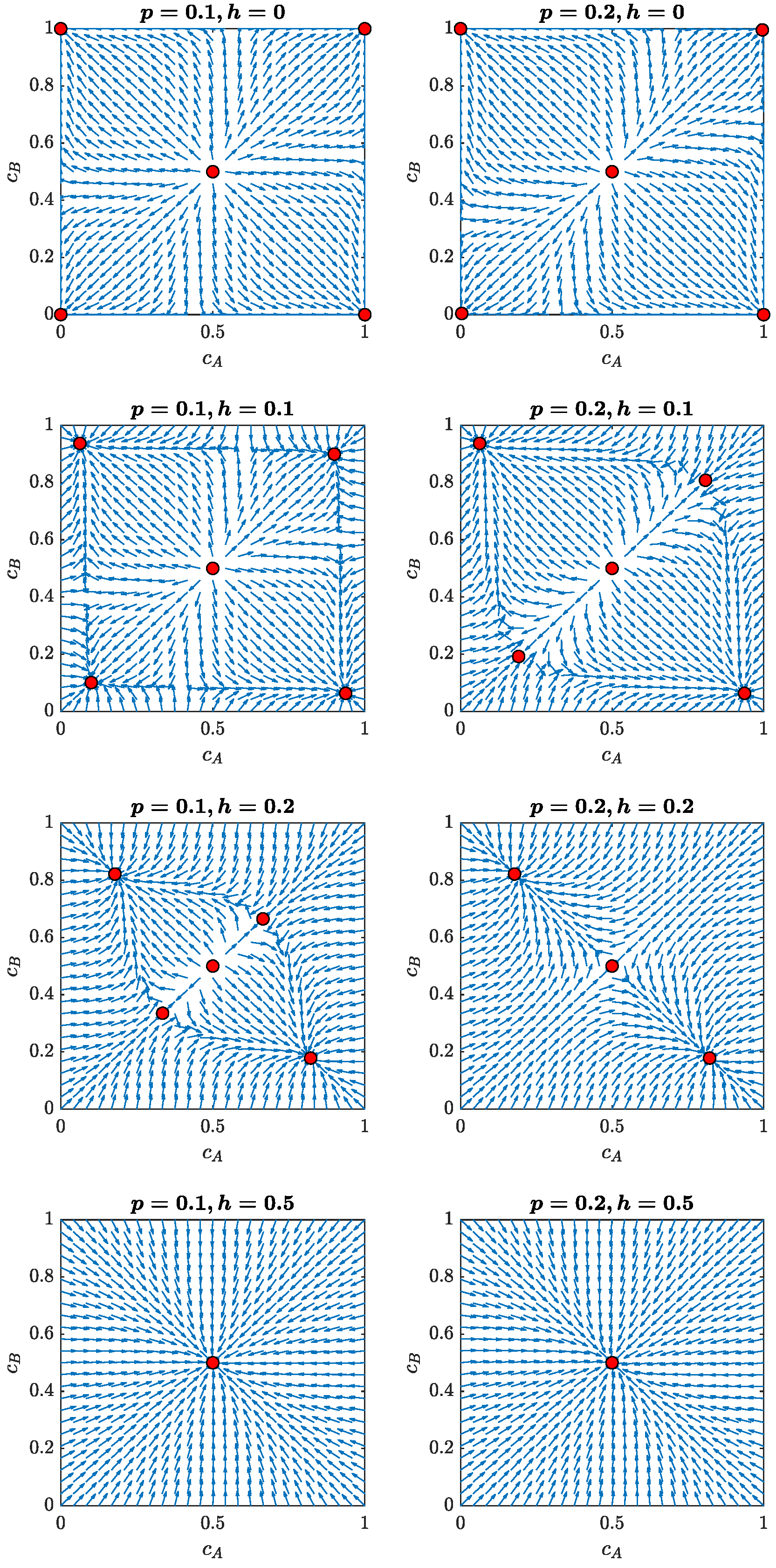
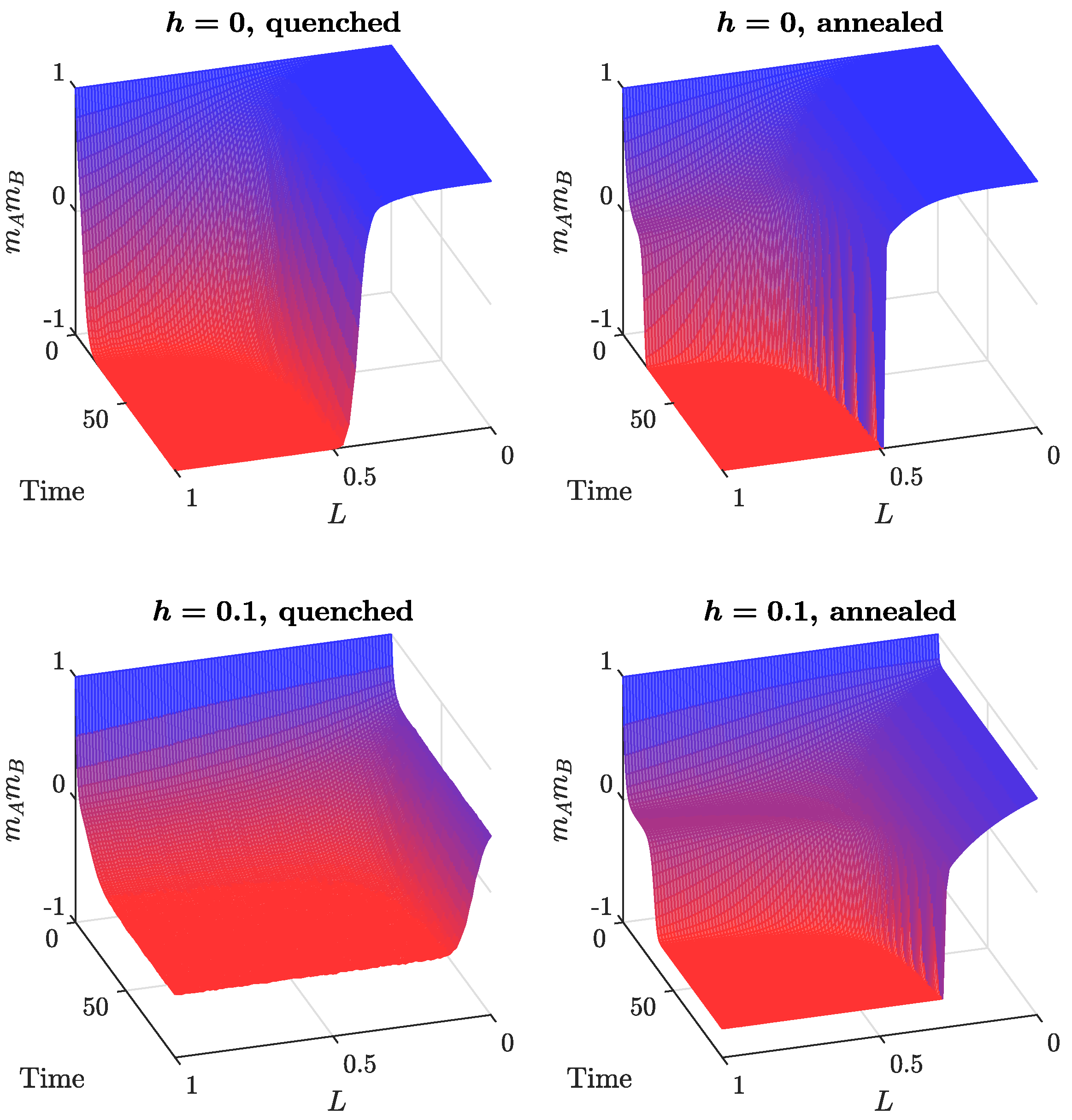
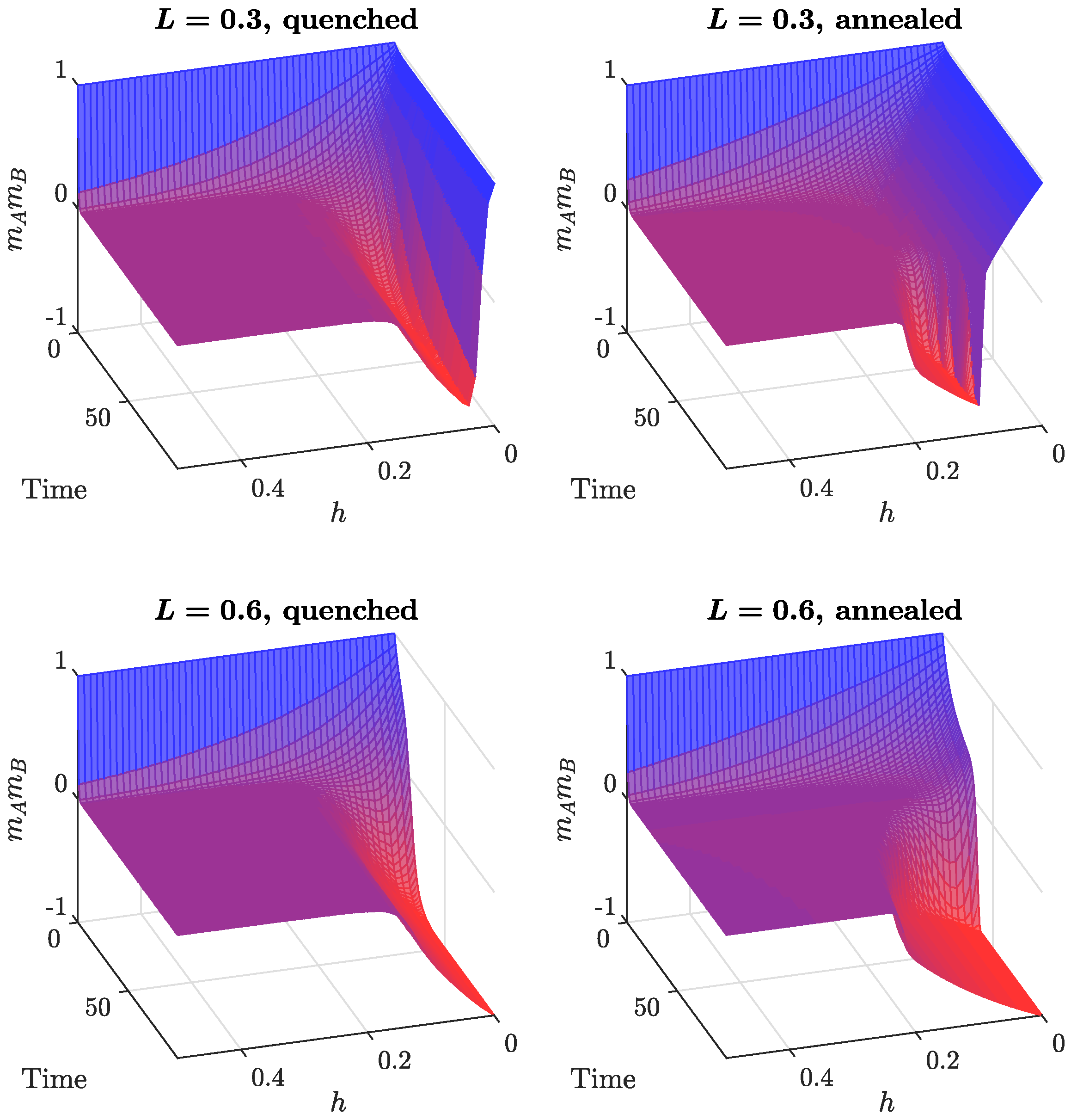
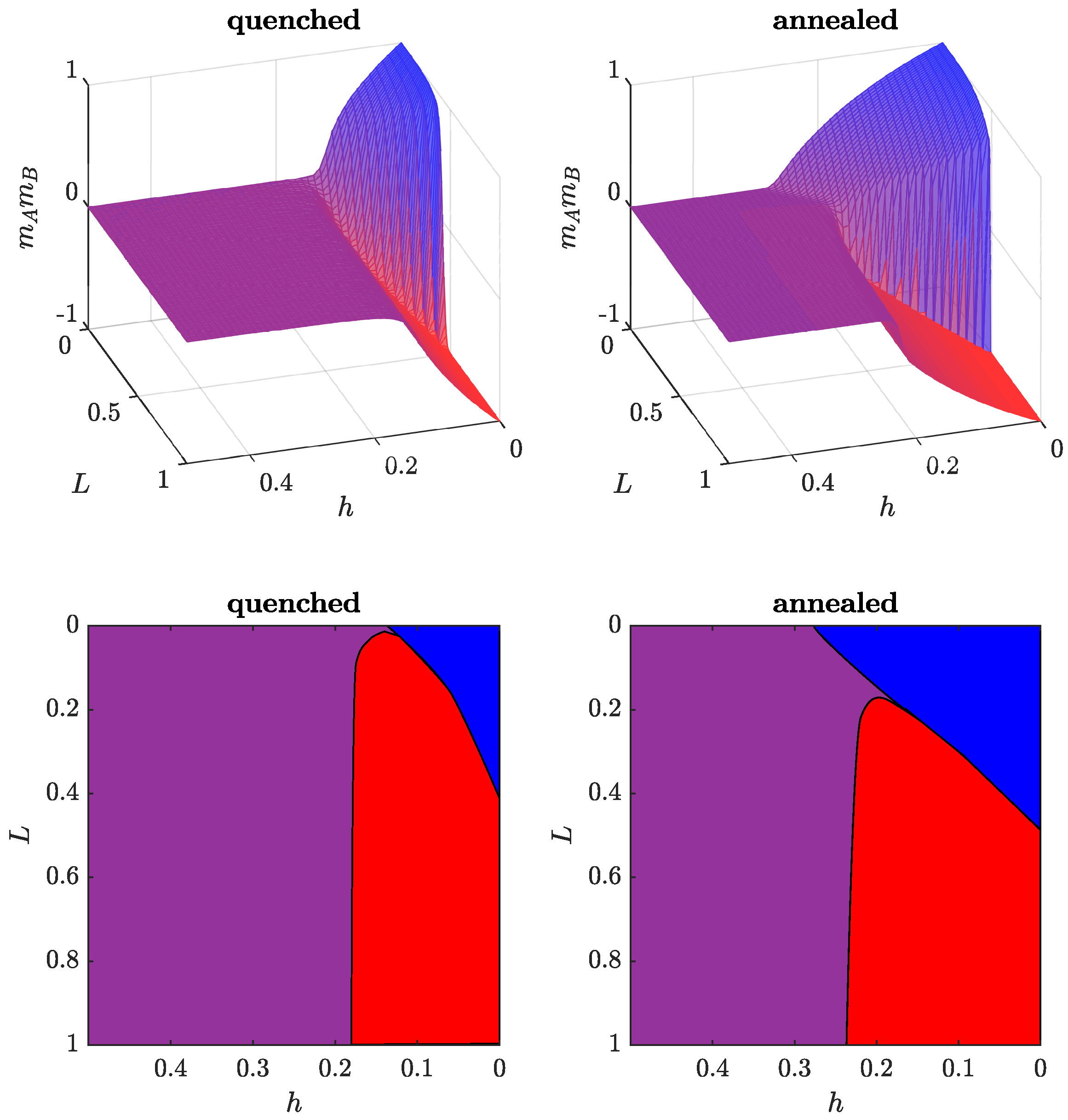
| Meaning | ||
|---|---|---|
| Positive consensus (all agents in clique X in state ) | ||
| Partial positive consensus (majority of agents in clique X in state ) | ||
| No ordering in clique X | ||
| Partial negative consensus (majority of agents in clique X in state ) | ||
| Negative consensus (all agents in clique X in state ) |
Publisher’s Note: MDPI stays neutral with regard to jurisdictional claims in published maps and institutional affiliations. |
© 2022 by the authors. Licensee MDPI, Basel, Switzerland. This article is an open access article distributed under the terms and conditions of the Creative Commons Attribution (CC BY) license (https://creativecommons.org/licenses/by/4.0/).
Share and Cite
Weron, T.; Szwabiński, J. Opinion Evolution in Divided Community. Entropy 2022, 24, 185. https://doi.org/10.3390/e24020185
Weron T, Szwabiński J. Opinion Evolution in Divided Community. Entropy. 2022; 24(2):185. https://doi.org/10.3390/e24020185
Chicago/Turabian StyleWeron, Tomasz, and Janusz Szwabiński. 2022. "Opinion Evolution in Divided Community" Entropy 24, no. 2: 185. https://doi.org/10.3390/e24020185
APA StyleWeron, T., & Szwabiński, J. (2022). Opinion Evolution in Divided Community. Entropy, 24(2), 185. https://doi.org/10.3390/e24020185







